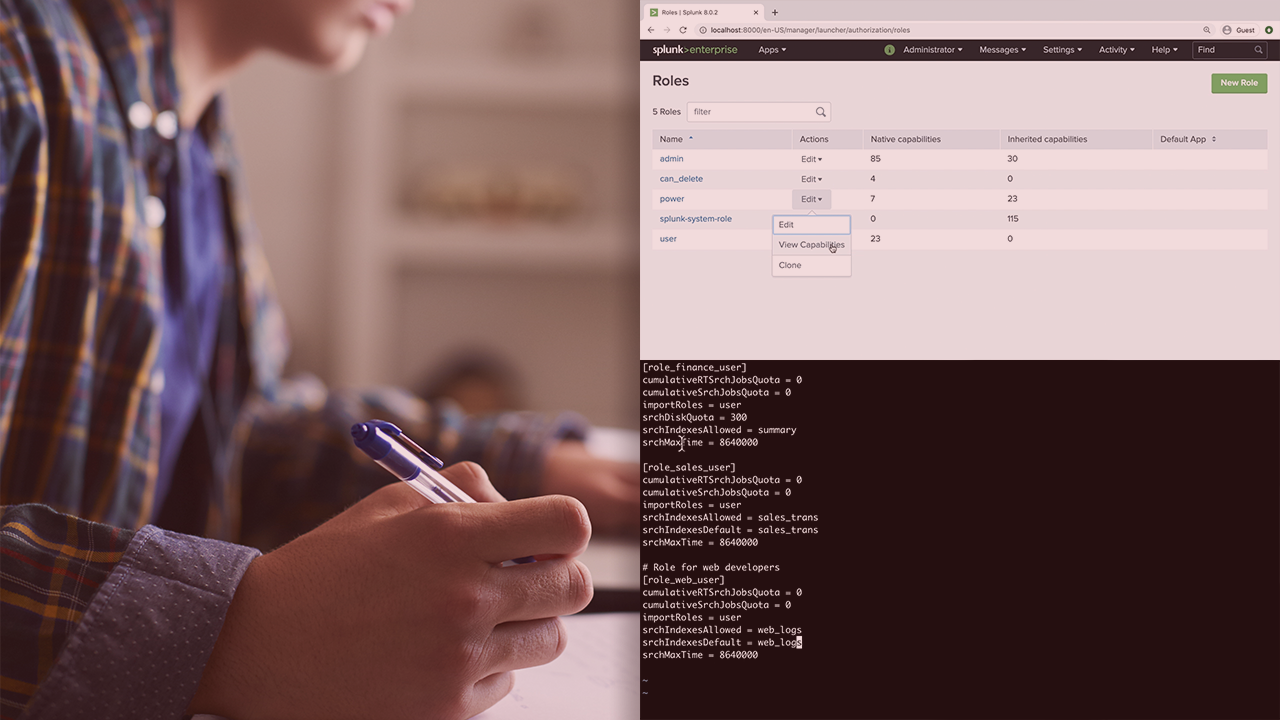
Get IdP Metadata Details to upload to Splunk Enterprise platform: Your application is saved successfully.To upload respective app logo for a Custom SAML App, click on Upload Logo tab.Click Next, now in the Attribute Mapping configure the following 3 attributes as shown in the image below.
 In Basic Settings tab fill the following details:. Go back to your miniOrange Admin Dashboard to configure the SSO for Splunk platform to authenticate using SAML by adding the Splunk application in admin portal as a Service Provider.
In Basic Settings tab fill the following details:. Go back to your miniOrange Admin Dashboard to configure the SSO for Splunk platform to authenticate using SAML by adding the Splunk application in admin portal as a Service Provider. #SPLUNK AUTHENTICATION CONF DOWNLOAD#
Download the SP Metadata File as shown in the below image which you will need further to configure the SAML SSO in miniOrange:. The SAML configuration dialog box appears. Click on the SAML Configuration button on the top right corner. For External Authentication Method, select SAML, then click on the link Configure Splunk to use SAML that appears. From the systems bar click on Settings > Authentication Methods. Log into the Splunk application as an administrator level user. Obtain the SP Metadata file from the Splunk application platform:. The Splunk platform instance must be able to contact the SAML IdP over the network. The user you use to log into the application platform must hold a role with the change_authentication capability. miniOrange or your Active Directory configured to provide the role, realName, and mail attributes for the SSO user. Contact the Splunk Enterprise Support team and request that they enable SAML 2.0 for your account. A running Splunk application platform instance that has access to the supported IdP with administrator access. Before you can configure SAML as an authentication scheme for single sign-on, you must have the following:. Prerequisites to configure single sign-on for Splunk Platform to authenticate into Idp using SAML as an authentication scheme: Search for Splunk Enterprise in the list, if you don't find Splunk Enterprise in the list then, search for custom and you can set up your application via Custom SAML App. 
 In Choose Application Type click on SAML/WS-FED application type. Go to Apps and click on Add Application button. Configure Splunk Enterprise in miniOrange MiniOrange provides user authentication from various external sources, which can be Directories (like ADFS, Microsoft Active Directory, Azure AD, OpenLDAP, Google, AWS Cognito etc), Identity Providers (like Shibboleth, Ping, Okta, OneLogin, Ke圜loak), Databases (like MySQL, Maria DB, PostgreSQL) and many more.įollow the Step-by-Step Guide given below for configuring the Splunk Enterprise Platform Single Sign-on (SSO) with SAML 2.0 authentication Scheme 1. IdP Initiated Single Sign-On (SSO) (for SSO access through the miniOrange Identity User Portal). SP Initiated Single Sign-On (SSO) (for SSO access directly through the Splunk web application). You can configure Splunk for either or both types of SSO. MiniOrange and Splunk Enterprise Single Sign-on (SSO) integration supports the following features. Follow the given SSO setup guide to integrate SAML SSO for your Splunk Enterprise account. With miniOrange SSO services, along with Splunk Enterprise you can also login into other On-Premise and Cloud Applications using your existing Identity Providers/User Store (Azure Active Directory, Okta, Ping) credentials with certificates and encryption.
In Choose Application Type click on SAML/WS-FED application type. Go to Apps and click on Add Application button. Configure Splunk Enterprise in miniOrange MiniOrange provides user authentication from various external sources, which can be Directories (like ADFS, Microsoft Active Directory, Azure AD, OpenLDAP, Google, AWS Cognito etc), Identity Providers (like Shibboleth, Ping, Okta, OneLogin, Ke圜loak), Databases (like MySQL, Maria DB, PostgreSQL) and many more.įollow the Step-by-Step Guide given below for configuring the Splunk Enterprise Platform Single Sign-on (SSO) with SAML 2.0 authentication Scheme 1. IdP Initiated Single Sign-On (SSO) (for SSO access through the miniOrange Identity User Portal). SP Initiated Single Sign-On (SSO) (for SSO access directly through the Splunk web application). You can configure Splunk for either or both types of SSO. MiniOrange and Splunk Enterprise Single Sign-on (SSO) integration supports the following features. Follow the given SSO setup guide to integrate SAML SSO for your Splunk Enterprise account. With miniOrange SSO services, along with Splunk Enterprise you can also login into other On-Premise and Cloud Applications using your existing Identity Providers/User Store (Azure Active Directory, Okta, Ping) credentials with certificates and encryption. 
You can log into Splunk Enterprise using miniOrange credentials or Azure AD credentials or any of your existing identity providers (IdP). miniOrange supports many different types of identity providers for logins using SAML for authentication. Single Sign-On (SSO) solution by miniOrange provides secure Single Sign-On access into Splunk Enterprise web application for your users using a single set of login credentials with Security Assertion Markup Language (SAML) as an authentication scheme. Configure Splunk Enterprise SAML Single Sign-On (SSO)Ĭonfigure Splunk Enterprise SAML Single Sign-on (SSO).








 0 kommentar(er)
0 kommentar(er)
